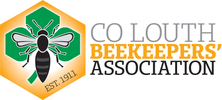Keeping Hive Records
To understand what's happening with your hives, it's important to keep historical records. These don't have to be complicated or exhaustive, but should capture the important aspects of how your hives are performing. Typically, these are kept under the hive roof and filled in on each visit, but they can be kept in a separate folder to allow you to examine them away from the apiary. And, of course, they can be kept electronically, although be aware that you will almost certainly forget some details if you don't record them while you are at the hive.
If you plan on taking the FIBKA Intermediate Apiary Practical exam, one of the requirements is that you can show hive records, so doing this is essential if you plan on taking this exam. Note that there is no specific format required for these, as long as the records show the work the beekeeper has done over the season and how the colonies have developed.
What you really want to follow is Ted Hooper's five questions (explained in detail by Dave Cushman):
There are many designs for record cards available and some links are added below. Here's one that allows you to track both REDDS and the queen's attributes:
If you plan on taking the FIBKA Intermediate Apiary Practical exam, one of the requirements is that you can show hive records, so doing this is essential if you plan on taking this exam. Note that there is no specific format required for these, as long as the records show the work the beekeeper has done over the season and how the colonies have developed.
What you really want to follow is Ted Hooper's five questions (explained in detail by Dave Cushman):
- R - Room: Does the queen have enough room to lay? Do the workers have enough room to store nectar and pollen?
- E - Eggs: Is the queen present and laying? Are there eggs and/or have you seen the queen?
- D - Development: Is the colony building up as expected? Are there queen cells?
- D - Disease: Are the bees healthy? Do they have noticeable mite loads? Any sign of foul brood, chalk brood, DWV, etc.?
- S - Stores: Does the colony have enough stores until the next inspection?
There are many designs for record cards available and some links are added below. Here's one that allows you to track both REDDS and the queen's attributes:
|
This is the template in multiple formats:
|
|
| ||||
Updated 8-April-2024
You can either print the document or update the spreadsheet. Alternatively, you could keep the spreadsheet in the cloud, e.g. Microsoft OneDrive or Google Docs, and you can update it at the hive from your mobile phone. I've copied it to OneDrive so you should be able to make a copy of it.
Note that this new version of the spreadsheet has a few changes:
You can either print the document or update the spreadsheet. Alternatively, you could keep the spreadsheet in the cloud, e.g. Microsoft OneDrive or Google Docs, and you can update it at the hive from your mobile phone. I've copied it to OneDrive so you should be able to make a copy of it.
Note that this new version of the spreadsheet has a few changes:
- Each hive still has its own sheet, but the queen now has a separate ID.
- The queen selection automatically ranks the queens in order of breeding quality.
- There is an extra column for propolis
Below is a selection of links to external sites which also have hive record templates you can use, and there are many more you can find around the web. However, the one above is the only one to explicitly refer to Ted Hooper's REDDS questions.
- BIBBA - National Bee Improvement Program - scroll down to "Record Card"
- BBKA - Beekeeping Records (explained in detail by Dave Cushman)
- Waveney Beekeepers Group - Hive Record Card
- Talking with Bees - Hive Record Card
- Wimbledon Beekeepers - Hive Record Card
- Cumann Beacharí Chonamara - Colony Records
- Gwenynwyr Conwy - Hive records - this also has a link to their winter preparation record card.

